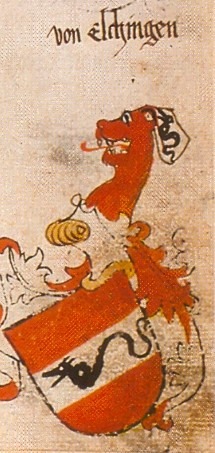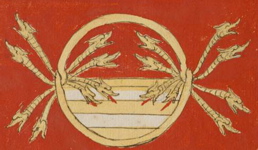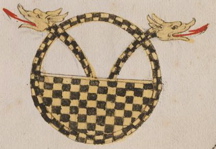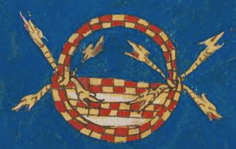Snakes, Adders: Difference between revisions
(Imported from Wikispaces) |
No edit summary |
||
| (4 intermediate revisions by 2 users not shown) | |||
| Line 5: | Line 5: | ||
''<span style="background-color: #eef3f6; color: #222222; font-family: monospace;">Revised {$revisiondate}.</span>'' | ''<span style="background-color: #eef3f6; color: #222222; font-family: monospace;">Revised {$revisiondate}.</span>'' | ||
---- | ---- | ||
=Illustrations:= | |||
==Period source:== | |||
{| class="wikitable" | |||
| [[File:UniverseelWapenboek_hm1080_scalyVSvair_contrast.jpg|180x227px|c.1558]] | |||
| [[File:Ingeramc1450serpent.jpg]] | |||
|- | |||
| c.1558 Universeel Wapenboek, KM1080, scaly vs. vair? argent on argent? | |||
| Serpent, Ingeram Codex, c. 1450, German | |||
|} | |||
===Calderas Gringoladas (snake handled cauldrons):=== | |||
http://coblaith.net/Heraldry/Regional/Calderas/default.html | |||
{| | |||
| http://coblaith.net/Heraldry/Regional/Calderas/caldera1.jpg | |||
| http://coblaith.net/Heraldry/Regional/Calderas/caldera2.jpg | |||
| http://coblaith.net/Heraldry/Regional/Calderas/caldera3.jpg | |||
|- | |||
| BSB 290, Armas de los Condes, f52r, caldera gringolada | |||
| BSB 290, Armas de los Condes, p57r, caldera gringolada | |||
| BSB 290, Armas de los Condes, f97r, caldera gringolada | |||
|- | |||
|[[File:LivroArmeiro_f084_PachecoChefe_OrOr.jpg|Livro]] | |||
|- | |||
|Livro do Armeiro Mor, Portugal, 1506-09, Pacheco Chefe, Or on Or caldeiras gringoladas | |||
|} | |||
See [[Cauldron]]. | |||
==Modern== | |||
'''Pictorial Dictionary of SCA Heraldry (3rd edition):''' | '''Pictorial Dictionary of SCA Heraldry (3rd edition):''' | ||
<span style="display: block; font-family: inherit; vertical-align: baseline;"> | <span style="display: block; font-family: inherit; vertical-align: baseline;"> | ||
| Line 20: | Line 46: | ||
---- | ---- | ||
===<span style="font-family: Georgia,serif; font-size: 90%;">Parker's Heraldry:</span>=== | ===<span style="font-family: Georgia,serif; font-size: 90%;">Parker's Heraldry:</span>=== | ||
Adders, (old fr. givre or vivre, from lat. vipera) or asps: appear not to be distinguishable from serpents and snakes, except as regards size. They are represented as nowed, embowed, or erect. When not otherwise described they would be represented fesswise, but curling. Vipers’ heads also occur. | Adders, (old fr. givre or vivre, from lat. vipera) or asps: appear not to be distinguishable from serpents and snakes, except as regards size. They are represented as nowed, embowed, or erect. When not otherwise described they would be represented fesswise, but curling. Vipers’ heads also occur. | ||
| Line 99: | Line 126: | ||
===<span style="font-family: Georgia,serif; font-size: 90%;">The [[http://oanda.sca.org/ordinary/index.html|Ordinary ]]:</span>=== | ===<span style="font-family: Georgia,serif; font-size: 90%;">The [[http://oanda.sca.org/ordinary/index.html|Ordinary ]]:</span>=== | ||
[[Category:Armory]] [[Category:Need Work]] | |||
Latest revision as of 18:31, 22 June 2019
WARNING: Do not cite this page as a reference. This page is on this wikispace only to make the content "searchable" and easier to find. If you find the information you seek here, go to the original sources as linked below to verify the information and use them for your documentation. Revised {$revisiondate}.
Illustrations:[edit | edit source]
Period source:[edit | edit source]
| c.1558 | 
|
| c.1558 Universeel Wapenboek, KM1080, scaly vs. vair? argent on argent? | Serpent, Ingeram Codex, c. 1450, German |
Calderas Gringoladas (snake handled cauldrons):[edit | edit source]
http://coblaith.net/Heraldry/Regional/Calderas/default.html

|

|

|
| BSB 290, Armas de los Condes, f52r, caldera gringolada | BSB 290, Armas de los Condes, p57r, caldera gringolada | BSB 290, Armas de los Condes, f97r, caldera gringolada |
| Livro | ||
| Livro do Armeiro Mor, Portugal, 1506-09, Pacheco Chefe, Or on Or caldeiras gringoladas |
See Cauldron.
Modern[edit | edit source]
Pictorial Dictionary of SCA Heraldry (3rd edition):
- Eel (see also sea-serpent)
- [[1]]
Illustration/s from Brickbat's Armorial Stash - [[2]]:
Pennsic Traceable Art Project:
Parker's Heraldry:[edit | edit source]
Adders, (old fr. givre or vivre, from lat. vipera) or asps: appear not to be distinguishable from serpents and snakes, except as regards size. They are represented as nowed, embowed, or erect. When not otherwise described they would be represented fesswise, but curling. Vipers’ heads also occur. > Gules, an adder nowed or–NATHERLY. > Sable, three chevrons ermine between as many adders argent–WISE, Warwick. The same between three adders erect or–WISE, Brompton. Also embowed vert–WISE. > Vert, three adders erect argent–HASSELL, Wraysbury. > Azure, on a bend argent, three adders embowed of the first–CASTLETON, Surrey. > Argent, three viper’s heads erased proper–HATSELL, 1708. > Vert, three asps in pale or–ASPENDALL. [[3]]
Serpent: the serpent or snake, for they are in heraldry absolutely synonymous, (fr. serpent), is found in the ancient rolls under the name of bis; the word survives in the Italian biscia, or cobra of Milan. The [[4]] occurs rather frequently in coats of arms, and its position should be described. As seen in the case of the arms of CAIUS above, it may be represented erect. It may also be drawn gliding or fessways. It may be involved or encircled(both terms meaning the same), as shewn in the margin, in which position it occurs in the arms of WHITBY Abbey. The [[5]] was probably suggested by the fossil Ammonites, found in the lias clay there, and which were at first supposed to be petrified snakes. When involved, the French heralds seem to use the word guivre for snake.
> Le Counte de TRERSTEYN, dor a un byse de goules–Roll, temp. HEN. III. > Monsire William MALBIS, d’argent a une cheveron de gules a trois testes de bys rases gules–Roll, temp. ED. III.
> Argent, a chevron gules between three serpents erect proper–COTTER, Bart, 1763.
> Argent, two serpents erect endorsed–LONGSHARE. > Or, three serpents erect wavy sable–CODLEW, or CUDLEW. > Argent, three serpents gliding in pale azure–DUCAT. > Argent, two bars gules; over all as many serpents erect, respecting each other, vert–REFUGE. > Argent, a serpent involved vert–O’DRONE, Ireland. [Another family, three snakes involved vert.] > Argent, three serpents voluted–DIGON, or TROGONE, Ireland. > Azure, three serpents encircled or; two and two–WHITBY Abbey. > D’argent à la guivre d’azur, tortillante en pal, [generally blazoned 'couronnée d'or,'] ‘engloutissante un enfant’ issante de gueules–Duché. de MILAN. Snakes are also represented [[6]], (q.v.), or twisted in a knot. In the [[7]] of CAVENDISH the reptile is represented as in the margin, and theoretical heralds contend that if represented as in the lowest of the two figures it would be [[8]] reversed. Also, as will be seen, there are complications of the nowed position. One or two other varieties are given, but heraldic writers such as Holme devote several pages to imaginary positions of serpents, and fanciful terms to fit them, none of which, however, are found to occur in any coats of arms. They are sometimes represented with tails in their mouths; at others round a pillar, or round necks of children. (See [[9]] of VAUGHAN under Enveloped.) See also [[10]], from which there is little or nothing to distinguish the charge in heraldic drawing.
> Argent, two serpents nowed and linked together in pale between two stars gules–ARWELL, Scotland. > Gules, three snakes nowed in triangle argent–EDNOWAIN AP BRADWEN, Merionethshire. > Gules, three snakes nowed in triangle argent, within a bordure engrailed or–LEWIS, Warwickshire. > Vert, a serpent bowed embowed debruised, the head erect, the tail torqued or–BLOORE. > Azure, three serpents, each encircled, their tails in their mouths argent[in French blazon, 'D'azur, a trois serpents d'argent arrondis se mordant la queue, posées 2 et 1']–DE LAUZON, Poitou. > Azure, a bend or in chief three boy’s heads couped at the shoulders argent, each enwrapped about the neck with a snake proper; in base as many griffin’s heads erased of the third–MADOCK, co. Gloucester. > Gules, a stellion[?] serpent proper–BUME. [[11]]
Precedents:[edit | edit source]
Precedents of the SCA College of Arms - [[12]] Morsulus Heralds Website - [[13]] (to search the LoARs and Precedents) Restatement Wiki - [[14]] (restatements of Precedents) Use the above links to be sure any precedents listed below haven't been superseded by newer precedents.
#x--Precedents:-Definition:Definition:[edit | edit source]
From the July 2012 Cover Letter: From Wreath: Involved Serpents In Society blazon, we have frequently blazoned the motif of a serpent or dragon curled in a circle and biting its own tail as involved// or //involved in annulo//. As the period blazon term //involved// appears reserved for serpents curled into a spiral shape, not into an annulet, we need to be able to distinguish between these postures. Therefore we will no longer use the term //involved// for charges actually in annulo; instead, we will use the term //in annulo vorant of its own tail// or some other similar blazon. Registered items using just //involved// that are in annulo will be reblazoned this month; other items using //involved in annulo will be reblazoned as needed in the future. [[15]]
#x--Precedents:-Registerability:Registerability:[edit | edit source]
(Restricted, Reserved, SFPP, OOP)
#x--Precedents:-Conflict:Conflict:[edit | edit source]
In the cases of charges nowed (e.g. serpents nowed,// or //lions with nowed tails), we've held that "knots is knots" and granted no difference for the exact form of knotwork. http://heraldry.sca.org/loar/1993/08/lar.html, Middle, Kingdom of the. Name and badge for Order of the Cavendish Knot. (fieldless) A Cavendish knot vert.
#x--Precedents:-Identifiability:Identifiability:[edit | edit source]
#x--Precedents:-Collected Precedents:Collected Precedents:[edit | edit source]
Tenure of Elisabeth de Rossignol (May 2005 - July 2008) - The 2nd Tenure of François la Flamme (October 2004 - May 2005) - The Tenure of Shauna of Carrick Point (May 2004 - August 2004) - The Tenure of François la Flamme (August 2001 - April 2004) - The Tenure of Elsbeth Anne Roth (June 1999 - July 2001) - The Tenure of Jaelle of Armida (June 1996 - June 1999) - The 2nd Tenure of Da'ud ibn Auda (November 1993 - June 1996) - The Tenure of Bruce Draconarius of Mistholme (June 1992 - October 1993) - The 1st Tenure of Da'ud ibn Auda (June 1990 - June 1992) - The Tenure of Alisoun MacCoul of Elphane (September 1986 - June 1990) - The Tenure of Baldwin of Erebor (August 1984 - August 1986) - The Tenure of Wilhelm von Schlüssel (August 1979 - August 1984) - The Tenure of Karina of the Far West (December 1975 - June 1979) - The Early Days (June 1971 - June 1975) -